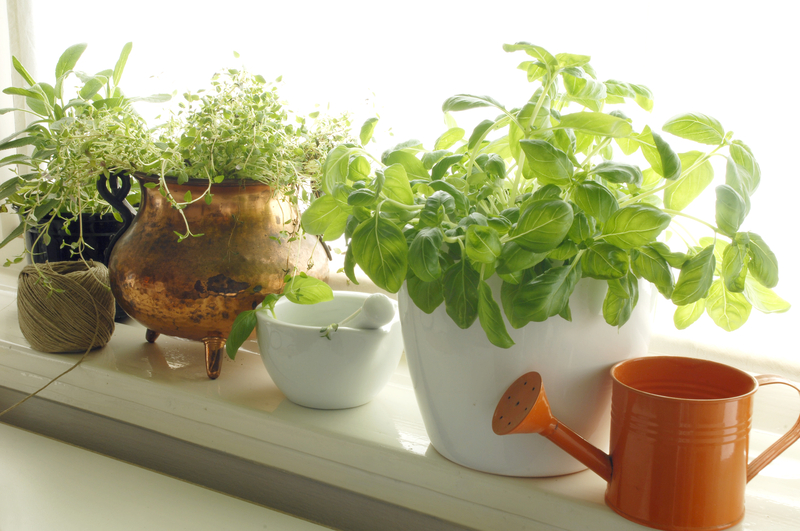The Healing Touch of Gardening for Our Climate
Posted on 17/09/2025
The Healing Touch of Gardening for Our Climate
Gardening is much more than just a hobby or a pastime. In the modern world, gardening's impact on the climate is gaining recognition for its remarkable potential to heal the planet. By nurturing plants, we also nurture the Earth, restoring ecosystems and countering environmental challenges. In this comprehensive article, we explore the healing power of gardening for the climate, the science behind its benefits, and practical ways you can turn your own outdoor space into a climate solution.

Why Gardening Matters for Our Climate
Climate change is one of humanity's biggest challenges. Rising global temperatures, erratic weather patterns, and degraded ecosystems threaten the world as we know it. Amid calls for innovative solutions, climate-friendly gardening emerges as a grassroots answer that everyone can participate in. Gardening isn't just about pretty flowers--it's a profound way to reduce carbon footprints, restore soils, and create microclimates that cool urban and rural areas alike.
- Carbon Sequestration - Plants absorb carbon dioxide (CO2), a major greenhouse gas, and store it in their tissues. Even small gardens help lock carbon away from the atmosphere.
- Promoting Biodiversity - Diverse gardens provide habitats for pollinators, birds, and soil life, reversing losses in nature caused by urbanization and monocultures.
- Reducing Urban Heat - Vegetated areas cool their surroundings through shade and the process of transpiration, combating the urban heat island effect.
- Stormwater Management - Gardens intercept rainwater, reduce runoff, and help recharge groundwater, preventing flooding and soil erosion.
- Producing Local Food - Growing food at home reduces the need for long-distance transport, cutting emissions from distribution networks.
The Science Behind Gardening's Climate Benefits
Carbon Capture and Storage
Plants are nature's carbon sinks. Through photosynthesis, they absorb carbon dioxide from the air and convert it into plant material. While forests are famous for this process, even small-scale home gardens act as mini carbon sinks. By increasing green cover in urban settings, gardeners can collectively sequester significant amounts of CO2. Composting plant matter adds even more carbon storage by building up organic content in the soil.
Soil Health and Regeneration
Healthy soils are crucial allies in the fight against climate change. Gardening methods such as mulching, composting, and abstaining from chemical fertilizers improve soil structure and fertility. Enhanced soils hold onto more water and store greater amounts of carbon, preventing it from returning to the atmosphere. Regenerative gardening techniques like no-dig practices help preserve soil life, which plays a vital role in nutrient cycling and carbon sequestration.
Biodiversity Restoration
Our climate is inextricably linked with biodiversity. By increasing plant diversity and embracing native species, gardens become sanctuaries for insects, birds, and small mammals. This restoration of biodiversity bolsters ecological resilience and helps pollinators--especially bees and butterflies--thrive, which is essential for both wild ecosystems and human agriculture.
The Healing Power of Gardens: Environmental, Physical, and Mental Health
Environmental Restoration
Gardens reverse many negative effects of human development. Bare soil is prone to erosion, but plant roots anchor it in place. Where chemical lawns contribute to pollution, organic gardens use natural fertilizers and pest control to maintain balance without harming local waterways or wildlife. Edible gardening reduces dependency on industrial food systems known for high carbon emissions.
Mental Wellness
Beyond environmental impacts, the healing touch of gardening extends to human mental health. Spending time in gardens reduces stress, anxiety, and depression. Studies show that connecting with nature has therapeutic effects, lowering blood pressure, improving focus, and enhancing mood. In an era of climate anxiety, engaging with the earth through gardening provides a powerful sense of agency and hope.
Physical Health Benefits
Engaging in gardening involves movement, fresh air, and exposure to sunlight--all essential for physical well-being. Growing your own organic produce leads to a healthier diet with more fruits and vegetables and less processed food. In addition, regular gardening lowers the risk of heart disease and strengthens muscles and joints.
Turning Your Garden into a Climate Solution
Sustainable gardening practices are the key to unlocking the full climate-healing potential of your garden. Whether you have a balcony, a small backyard, or access to community plots, everyone can participate in the restoration of our planet.
Practical Steps to Enhance Your Garden's Climate Impact
- Go Organic - Avoid synthetic fertilizers and pesticides. Use compost, organic mulch, and natural pest controls to keep your soil and plants healthy.
- Plant Trees and Perennials - Trees and long-lived shrubs store more carbon over time. Native species provide the greatest benefit for local wildlife and require less maintenance.
- Maximize Plant Diversity - A variety of flowers, vegetables, herbs, and shrubs supports a wider array of beneficial insects and birds, and helps prevent pest and disease outbreaks.
- Focus on Soil Health - Practice no-dig gardening to protect soil organisms. Add compost and organic matter to feed the soil and sequester carbon.
- Harvest Rainwater - Install rain barrels or swales to collect rainwater for irrigation. This reduces reliance on municipal water supplies and reduces runoff.
- Support Pollinators - Plant pollinator-friendly flowers and avoid the use of chemicals that harm bees and butterflies.
- Grow Your Own Food - Incorporate fruits, vegetables, and herbs into your gardening routine to cut food miles and improve food security.
Community Gardening: Amplifying the Healing Touch
While individual action has merit, community gardening exponentially multiplies the impact. Shared green spaces not only rejuvenate neighborhoods but also build social cohesion, improve air quality, and educate people about sustainable living. Community gardens can transform abandoned lots into productive oases, provide fresh produce in food deserts, and offer green refuges to urban residents.
- Tackling Urban Heat Islands - Green roofs and community gardens cool down city blocks and make neighborhoods more livable during heatwaves.
- Enhancing Social Resilience - Gardening together fosters community bonds, encourages knowledge sharing, and increases resilience during times of crisis.
- Educational Opportunities - Teaching children and adults about climate-positive gardening builds a new generation of eco-conscious citizens.
The Role of Technology and Innovation in Gardening for Our Climate
Modern solutions and ancient wisdom blend seamlessly when it comes to climate-smart gardening. Innovations such as smart irrigation systems, permaculture principles, and vertical gardens make it easier to maximize impacts even in the tightest of spaces. Urban farmers are turning rooftops into productive gardens, using hydroponics and aquaponics to conserve water and space while producing fresh food.
- Smart Watering Solutions - Drip irrigation, soil moisture sensors, and rainwater harvesting minimize water use and optimize plant health.
- Green Infrastructure - Green walls, rooftop gardens, and living fences improve city air, reduce heat, and enhance local biodiversity.
- Permaculture Design - By designing with nature in mind, gardeners can create self-sustaining systems that mimic natural ecosystems and boost climate resilience.
Gardening and Climate Advocacy: Your Voice Matters
The healing power of gardening for the climate isn't just about what you grow--it's also about inspiring others. Share your successes and lessons learned. Organize workshops, offer seeds and seedlings, and advocate for more public green spaces. Encourage schools and local governments to prioritize green infrastructure and sustainability in urban planning.
Your garden can be a beacon of hope and a catalyst for change.
Challenges and Considerations for Climate-Smart Gardening
No solution is without challenges. New and experienced gardeners alike may face issues such as poor soil, limited space, water restrictions, or local regulations. However, the climate-friendly gardening movement offers innovative strategies for overcoming these barriers:
- Small-space Solutions - Container gardening, vertical planting, and window boxes bring greening to even the smallest balconies.
- Dealing with Poor Soil - Raised beds, soil amendments, and compost turn even degraded soil into productive ground.
- Water-saving Techniques - Mulching, drought-tolerant plants, and efficient irrigation retain moisture and cut down on water use.
- Working with Local Conditions - Choose native and well-adapted plants for your region's climate and wildlife.
Stay informed about local regulations regarding pesticide use, planting trees, and water collection to ensure your gardening projects comply with the law and maximize their positive effects.
Success Stories: Gardening Projects That Heal the Climate
Across the globe, gardeners are witnessing the rewards of their climate-positive efforts. Let's take a look at a few inspiring examples:
- Edible Forest Gardens - Communities are transforming vacant land into food forests that mimic natural ecosystems, provide fresh produce, and attract pollinators.
- Urban Greening Initiatives - Cities like Singapore, Paris, and Melbourne are investing in rooftop gardens and green corridors to absorb CO2, cool city streets, and support wildlife.
- Restorative Agriculture Projects - Farmers and gardeners worldwide are restoring depleted soils through regenerative techniques, increasing production while drawing more carbon into the ground.
- School Gardens - Children learn hands-on about nature, nutrition, and sustainability, cultivating habits that benefit both their health and the planet.
How to Start Your Own Climate-Healing Garden
Ready to put your green thumb to work for the planet? Here's a step-by-step guide to creating a garden that heals both the climate and your community:
- Assess Your Space: Observe sunlight, soil type, water access, and local microclimates.
- Choose Climate-friendly Plants: Prioritize native, drought-tolerant, and perennial species.
- Improve Soil Health: Add compost, avoid digging when possible, and mulch to retain moisture.
- Practice Organic Techniques: Skip chemicals for natural methods to benefit soil life and pollinators.
- Reduce Resource Use: Install efficient irrigation, recycle garden waste, and collect rainwater.
- Encourage Biodiversity: Plant a wide range of species, include wildflower corners, and install birdhouses or insect hotels.
- Share and Learn: Connect with other gardeners, join community efforts, and mentor newcomers.

The Future: Gardens as Climate Healers
The healing touch of gardening for our climate is within reach for everyone. Each seed planted, each soil bed nurtured, and each bee supported helps shape a more resilient, sustainable future. As global challenges mount, gardens offer hope--a living connection to the Earth and a practical tool against climate change.
By embracing thoughtful, climate-positive gardening practices, we can create a world where gardens heal not just people, but the planet itself. Whether you're growing food, flowers, or wild spaces, you are part of the climate solution. Let your garden's healing touch extend beyond its boundaries, inspiring hearts, healing communities, and nurturing the Earth--one plant at a time.
Conclusion
The evidence is clear: Gardening for our climate offers tangible environmental, physical, and psychological benefits. With every small action, we collectively move towards a healthier, more balanced planet. Plant with purpose and be part of the healing touch our climate so desperately needs. Your garden is more powerful than you think--start today, and watch healing unfold.



